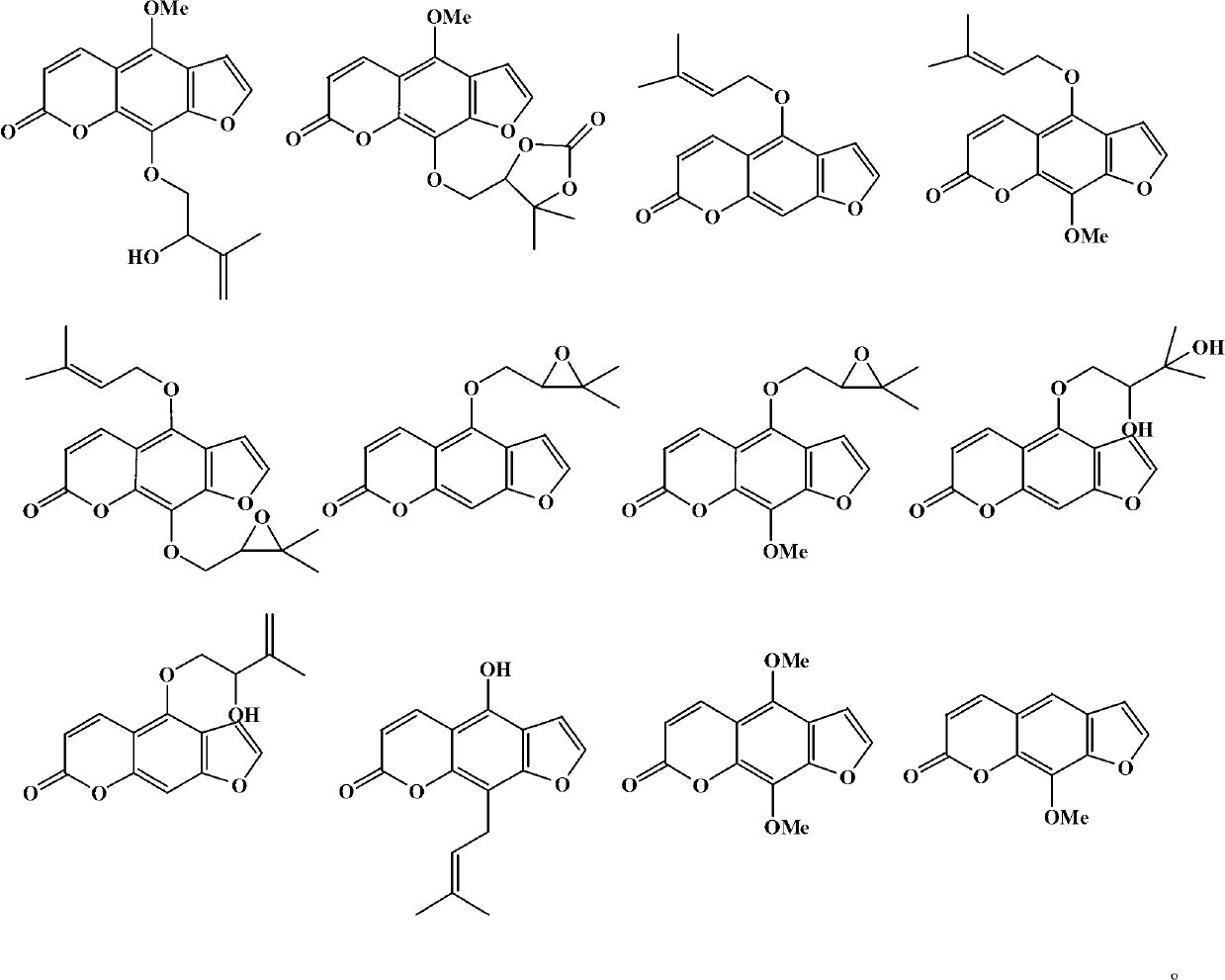Application of furan coumarin compound in reducing toxic effect of amide herbicide on crops
A technology for amide herbicides and furanocoumarins, which is applied in the fields of natural medicinal chemistry and pesticides to achieve the effects of eliminating damage, prolonging service life and expanding the scope of application
- Summary
- Abstract
- Description
- Claims
- Application Information
AI Technical Summary
Problems solved by technology
Method used
Image
Examples
Embodiment 1
[0019] Example 1 Preparation of bergamot lactone (5-methoxypsoralen) in compound general formula (I). Proceed as follows:
[0020] 1) Dried notopterygium roots and rhizomes are crushed into powder and passed through a 100-mesh sieve;
[0021] 2) Weigh 100g notopterygium powder, use 95% ethanol as the extraction solvent to reflux extract in a water bath at 90°C for 6-8 hours, and concentrate to obtain 20g paste extract, with a yield of 20%;
[0022] 3) Weigh 20 g of the ethanol-extracted Notopterygium notopterygii crude extract for preliminary separation by silica gel column chromatography, and perform gradient elution with petroleum ether-ethyl acetate (8:2, 7:3, 6:4, 5:5). The same fractions were combined by thin layer chromatography (TLC) to obtain Q 1 ~Q 10 A total of 10 components, component Q was found by laboratory bioassay 5 It has detoxification activity, it is freeze-dried and used for future use;
[0023] 4) Component Q 5 After further separation by high-speed ...
Embodiment 2
[0025] Example 2 Indoor test method of bergamot lactone to reduce the toxic effect of amide herbicide acetochlor on rice The rice used for testing was Jinyou 207, which was disinfected with sodium hypochlorite before use, and the soil was sterilized and dried without pesticides and other chemical substances. soil. Weigh 200g of soil and put it into a 13cm×8cm×5cm plastic box, add 100mL tap water and mix well, sow 20 rice seedlings with consistent germination in each box, and cultivate the rice in a light incubator.
[0026] When the rice grows to one leaf and one heart, it starts to apply pesticides. Dissolve bergamot lactone and herbicide acetochlor in chloroform, add water and acetic acid to prepare a mixed solvent, add Tween-80 to disperse. Mix 50mL of 0.1mg / L herbicide with 50mL of bergamot lactone (a series of concentrations: 5mg / L, 10mg / L, 20mg / L and 40mg / L) and pour them into the culture box (after mixing The concentrations of amine and bergamot lactone were diluted t...
Embodiment 3
[0030] Embodiment 3 bergamot lactone removes the tank planting test of acetochlor poisoning to rice
[0031] Acetochlor: 900g / L acetochlor EC
[0032] Rice for testing: Jinyou 207
[0033] In an area of 0.05m 2 Add the soil without herbicide application into the plastic bucket. Rice seeds are sown in barrels after germination, and treated with pesticides when the seedlings grow to the one-leaf stage. The treatment method is poisonous soil method, and the dosage is 1g of acetochlor per mu. The phytotoxicity could be observed 4 days after the application, and the phytotoxicity was obvious after 1 week, showing that the plants were dwarfed, and the plant height was significantly lower than that of the untreated rice at the same growth stage. After 6 weeks, it can be clearly found that compared with the untreated rice at the same growth stage, the number of tillers is less. And use 1g of acetochlor and bergamot lactone per mu at 0.3g / m 2 The dosage was mixed with soil, and ...
PUM
 Login to View More
Login to View More Abstract
Description
Claims
Application Information
 Login to View More
Login to View More - R&D
- Intellectual Property
- Life Sciences
- Materials
- Tech Scout
- Unparalleled Data Quality
- Higher Quality Content
- 60% Fewer Hallucinations
Browse by: Latest US Patents, China's latest patents, Technical Efficacy Thesaurus, Application Domain, Technology Topic, Popular Technical Reports.
© 2025 PatSnap. All rights reserved.Legal|Privacy policy|Modern Slavery Act Transparency Statement|Sitemap|About US| Contact US: help@patsnap.com



